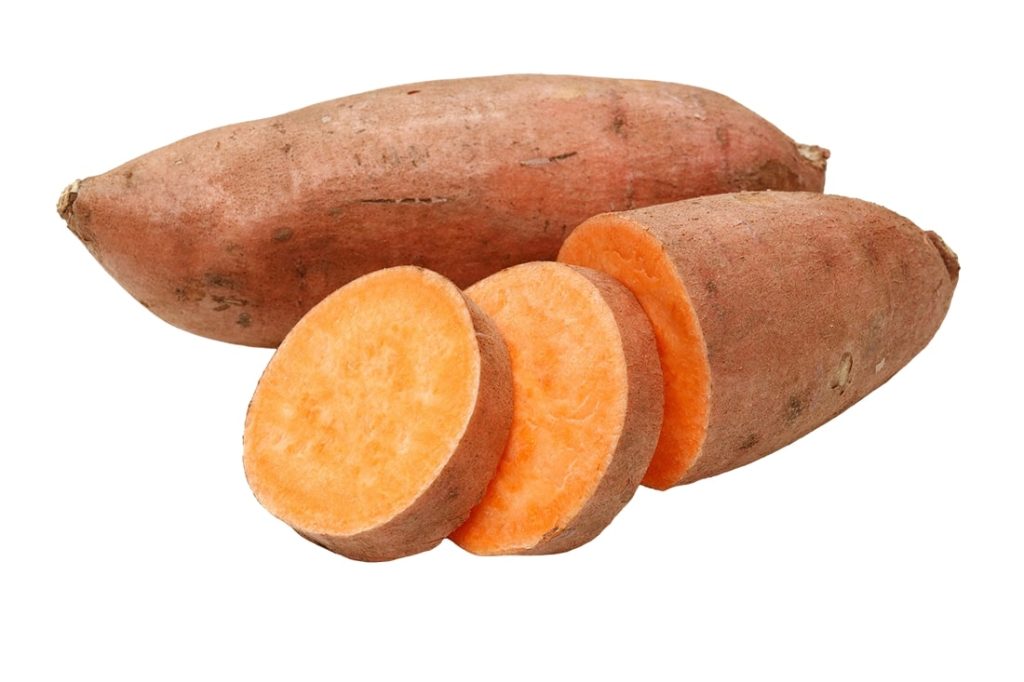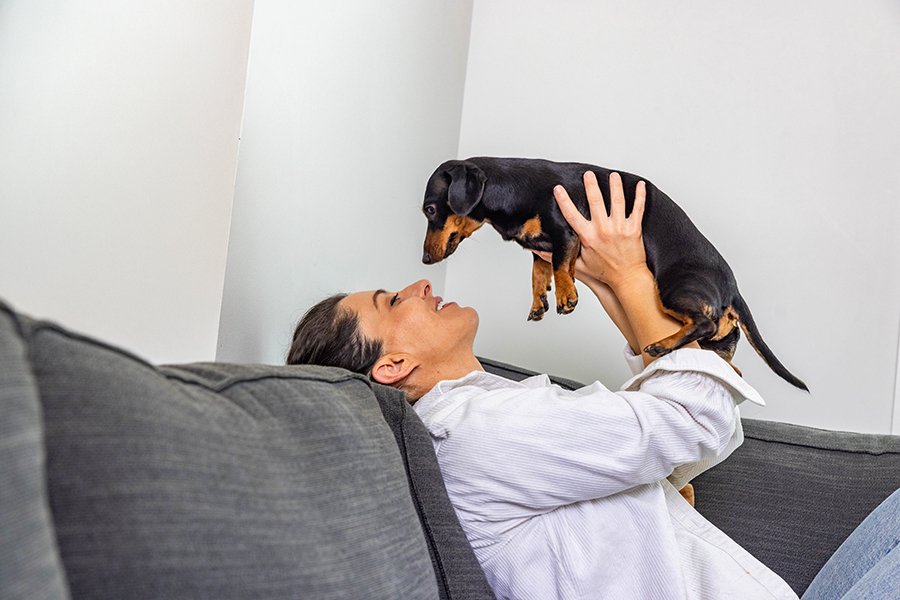Fiber for Dogs
As humans, we know that dietary fiber is an important element of our overall well-being, but what about our best furry friends? Here's what pet parents need to know about fiber for dogs.
As humans, we know that dietary fiber is an important element of our overall well-being, but what about our best furry friends? Do dogs need fiber? What is it, what are the sources of fiber that are best for your pooch, and how does it help your dog’s digestive system?
Let’s take a closer look at the facts about the fiber your dog eats.
What Is Fiber?

Fiber is a type of carbohydrate that comes from plants and doesn’t get digested. Instead of being something your dog’s digestive tract absorbs, it helps your dog’s body to digest other foods. It also helps in other important ways to optimize your dog’s health.
For this reason, it’s important to include high-fiber dog food as part of your dog’s diet. But there are different types of fiber that dogs need. Here’s the low down on those.
Soluble Fiber
Soluble fiber is a type of fiber that can be dissolved in water and is great for your dog’s gut health. When it reaches your dog’s colon, it helps him digest other foods by feeding the good bacteria that live in the colon. Soluble fibers, also known as prebiotics, stimulate the growth of good bacteria needed for healthy digestion.
Insoluble Fiber
Insoluble fiber doesn’t dissolve in water. Instead, it helps to bulk up your dog’s poop as it is moving through the colon. This both promotes regularity and gives your dog a feeling of fullness. The latter helps them remain satiated, which may help with weight loss and help your buddy stay at a healthy weight.
Fermentable Fiber
Fiber that ferments is beneficial for your dog’s gut in that it helps support a healthy colon. It also may help to guard against problems like obesity, cancer, and diabetes.
This is because fermentable fibers produce short-chain fatty acids. These have an antioxidant protective effect on cardiovascular disease and oxidative stress, the latter of which damages cells, proteins, and DNA.
Not all fiber, however, is fermentable. Soluble fiber tends to be more fermentable than insoluble fiber, but both have beneficial effects on your dog’s health and longevity. As with any other food item, however, moderation is key.
Though fermentation has a number of health benefits, too much can cause flatulence (gas) in dogs. That’s why you should strive to strike a balance between soluble and insoluble fiber intake.
When you consider the benefits of weight management, digestive health, and prebiotic protective factors, you can see why high-fiber diets provide essential nutrients for managing digestive issues, maintaining your dog’s overall health, and promoting regular bowel movements.
How Important Is Regularity for Your Dog?

Fiber-rich foods may help your dog stay regular. They do so by loosening poop and preventing constipation. Without enough fiber in his diet, your dog might have problems pooping, and most of us know how that feels.
That’s why the right amount of fiber in his pet food is critical. It’s especially important for dogs because they have two small glands beside their anus that secrete a liquid that allows dogs to mark their territory. If your dog is constipated, these can become inflamed, which will make your furry friend very uncomfortable.
Soluble fiber soaks up extra water in your dog’s colon and may help avoid anal gland issues by making watery bowel movements or diarrhea much less likely. Too much fiber, however, can have the opposite effect and cause loose stool.
By soaking up the extra water, fiber can help stop diarrhea, but it can also cause it if your dog is getting too much, so the key is to feed the proper amount of fiber. But what sources of fiber should you use and how much should you give?
What Sources of Fiber Should You Give Your Dog?

Of course, there are many benefits of fiber for your dog’s health, but too much of anything can be a bad thing, so how much fiber should you give your dog?
The easiest way to ensure you give your pooch all the fiber a dog needs is to feed a complete and balanced food. But if you’re unsure about your food’s fiber content, and you want to make sure by giving him an extra boost, you can add several things to his diet. (First, consult your vet.)
Here are some great sources of fiber that are healthy and safe for your dog:
- Beetroot pulp: Beet pulp has a high fiber content of around 11 – 19% of crude fiber. That makes it a great extra fiber source for your pup. But be aware that your dog’s poop could turn purple or red after eating it because of the natural dye in the vegetable.
- Sweet Potatoes: With approximately 4 grams of dietary fiber, sweet potatoes are another option for a high-fiber treat. They also taste good, so your best buddy is sure to love them.
- Pumpkin. Cooked pumpkin is a great fiber-rich food source for your dog. You can also add pureed pumpkin that you can put right on your dog’s regular dog food.
- Carrots. Carrots are not only a great source of fiber, they also have other essential nutrients like vitamins A, K, and B6. They can also be fed raw or cooked, which makes them even more convenient for you.
- Green veggies: Spinach, kale, green beans, and broccoli are all great fiber sources to add to your dog’s diet. You should, however, stick to fresh vegetables or snap-frozen vegetables as opposed to canned vegetables. Those might have other additives that are not so healthy for your pup. Also, be careful about how much you feed since an excess can cause bloating and discomfort.
- Apples. Apples are another great source of extra fiber. You shouldn’t feed the core or seeds, however, as these can be toxic for dogs.
- Brown rice. Brown rice is an ingredient in many high-fiber dog foods. But it can cause weight gain if you give too much.
- Strawberries and blueberries. These fruits not only contain fiber but antioxidants as well. They make a great fiber source, but you need to be aware that their high sugar content could be a problem for your dog. Again, moderation is key.
- Probiotics: Probiotics might be a good choice for your pooch if he has recently been on antibiotics or if there is a problem with your dog’s gut or his digestion. They are also helpful if your dog’s diet is high in feed-grade carbohydrates, which do not always promote a healthy gut microbiome. Probiotics differ from prebiotics in that probiotics contain healthy gut microorganisms, whereas, prebiotics, as mentioned, feed and thereby stimulate the growth of gut microorganisms. Probiotics can be fed as a supplement or by feeding your dog yogurt. You want to ensure, however, that the probiotics you feed contain the kind of bacteria normally found in the canine gut.
It’s important to note that dog kibble also contains fiber in the form of cellulose. Cellulose is an insoluble fiber, however, which means that you don’t want your dog to get too much from that source.
If you’re feeding dry dog food, you may want to mix in sources of soluble fiber to give your furry friend a more well-rounded and fibrous diet. Doing so may help him have smoother bowel movements and support a healthier digestive system.
How Much Fiber Should You Feed Your Dog?
Normally, the amount of fiber in an adult dog’s diet should be between 2.5 and 4.5%. The fiber content of some diet dog foods might be higher since fiber helps your dog feel full and eat less.
Some high-fiber diets might also help with managing blood glucose, and of course, they also help improve the function of the large intestine. If, on the other hand, your dog is getting too much fiber, you might notice loose stools, frequent defecation, and less desire to eat his food.
If you start to see these symptoms, you might want to speak with a veterinary nutritionist about how much fiber to give. You might try cutting back on the amount you’re feeding, but you don’t want to cut out other vital nutrients.
Do Senior Dogs Need More Fiber?

Senior dogs, just like humans, do need more fiber, particularly if they experience constipation. It can also help prevent obesity in older dogs who are less active.
There are, however, times when senior dogs should have less fiber. This is particularly true if they are having problems absorbing nutrients. That’s why it’s best to discuss your dog’s specific needs with your veterinarian or veterinary nutritionist.
Fresh, Whole Food Is a Great Source of Fiber
The best way to ensure your dog gets enough healthy fiber is to feed him high-quality dog food. We make several recipes that contain high-quality soluble and insoluble fibers. They are made with fresh, whole ingredients that are gently cooked to deliver human-grade nutrition.
This content is for informational use only and does not replace professional nutrition and/or medical advice, diagnosis, or treatment. It is not a substitute for and should not be relied upon for specific nutrition and/or medical recommendations. Please talk with your veterinarian about any questions or concerns.
Godoy, Maria R. C. de, Katherine R. Kerr, and George C. Fahey. 2013. “Alternative Dietary Fiber Sources in Companion Animal Nutrition.” Nutrients 5 (8): 3099–3117. https://doi.org/10.3390/nu5083099.
WebMD Editorial Contributors. 2021. “What Are Probiotics for Dogs?” WebMD. WebMD. March 14, 2021. https://www.webmd.com/pets/dogs/probiotics-for-dogs.
“A Science-Based Guide for Pet Owners.” 2006. https://nap.nationalacademies.org/resource/10668/dog_nutrition_final_fix.pdf.








